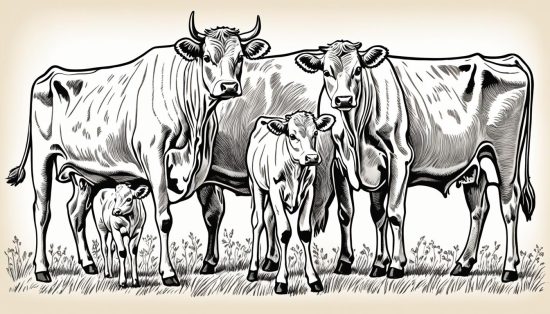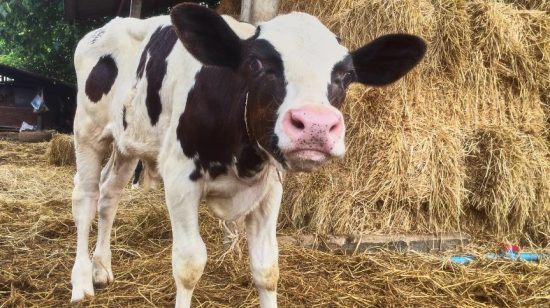How to Milk a Cow: A Friendly Guide for Beginners
Discover the art of dairy with our beginner’s guide on how to milk a cow efficiently and humanely, ensuring fresh milk every time.
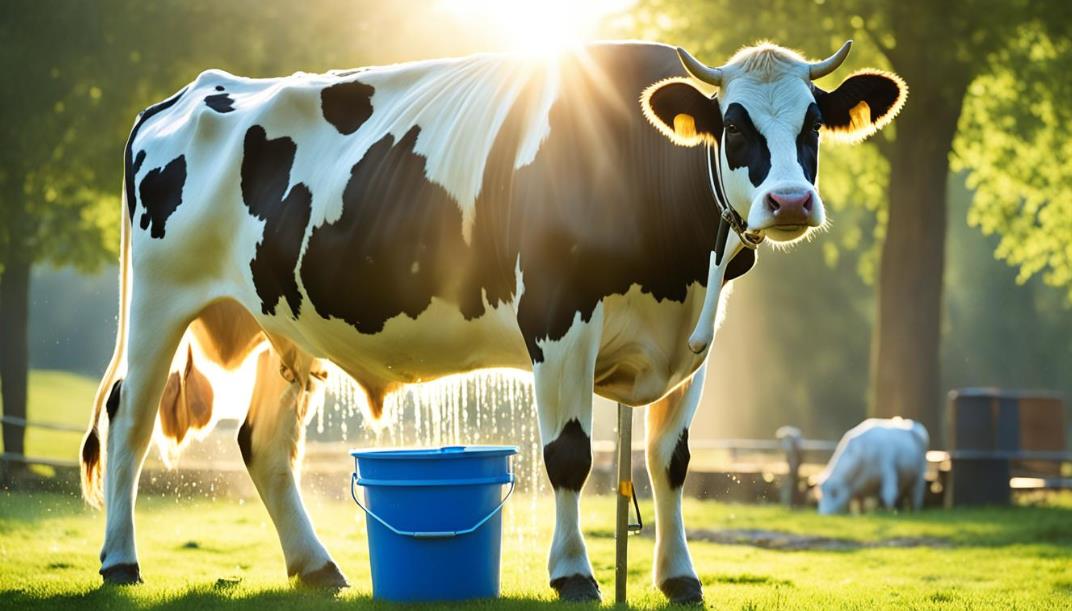
Did you know that a single dairy cow can produce up to 7 gallons of milk per day? That’s an impressive amount of liquid gold! If you’ve ever wondered how this milk makes its way from the cow to your breakfast table, you’re in the right place. Lets walk through the process step by step, providing all the information you need to confidently embark on your milking journey.
Understanding the Basics of Cow Milking
When it comes to milking a cow, it’s essential to have a good understanding of the basics. Wewill provide you with the knowledge you need to get started on your cow milking journey. We’ll cover important topics such as interpreting cow behavior to determine the right time to milk, the essential equipment you’ll need, and the importance of patience and consistency in the milking process.
Before you begin milking a cow, it’s crucial to observe and interpret their behavior to determine the ideal time. Cows have their own rhythm when it comes to lactation, and understanding their behavior can help you optimize milk production. Look for signs of discomfort, such as restlessness or kicking, which may indicate an uncomfortable udder. On the other hand, relaxed cows with filled udders and a calm demeanor are typically ready to be milked. By paying attention to these cues, you can ensure a more efficient and stress-free milking process for both you and the cow.
Essential Equipment for Milking a Cow
Having the right equipment is key to successful cow milking. Here are some essential items you’ll need:
- High-quality, food-grade buckets for collecting milk.
- Rubber boots to Keep your feet clean and protected while milking.
- Straining supplies like Strainers and filters to remove impurities from the milk.
Investing in reliable and durable equipment will not only ensure the hygiene and safety of the milk but also make the milking process more efficient and comfortable for both you and the cow.
Benefits of Patience and Consistency in Milking
When it comes to cow milking, patience and consistency are key. Patience is important because some cows may take longer to let their milk down, and rushing the process can lead to stress and discomfort for the cow. By staying calm and patient, you create a more relaxed environment, allowing the cow to release milk more easily. Additionally, consistency is crucial in cow milking. Milk your cows at the same time every day to establish a routine and optimize milk production. Consistency also helps maintain the cow’s comfort and prevents any unnecessary stress or discomfort.
By understanding cow behavior, having the right equipment, and approaching milking with patience and consistency, you’ll be well on your way to successful cow milking. Next, we’ll delve into the pre-milking preparations necessary for a smooth and efficient milking process.
Pre-Milking Preparation: Setting Up for Success
Before milking a cow, it is crucial to properly prepare and set up the milking environment to ensure a successful and efficient process. Pre-milking preparation involves several important steps that contribute to the overall hygiene and comfort of the cow, as well as the quality of the milk.
One of the key aspects of pre-milking preparation is creating a clean and comfortable milking environment. This includes ensuring that the milking area is free from dirt, debris, and excessive moisture. A clean environment helps minimize the risk of bacterial contamination and creates a more pleasant experience for both the cow and the milker.
Proper hygiene practices are also essential during pre-milking preparation. Before milking, it is important to wash your hands thoroughly with warm water and soap. This helps reduce the transfer of bacteria and maintain the integrity of the milk. Additionally, it is recommended to wear clean, disposable gloves during the process to further minimize the risk of contamination.
Another crucial step in pre-milking preparation is washing and drying the cow’s udder. This should be done using a clean cloth or disposable wipes that are specifically designed for this purpose. Gently clean each teat to remove any dirt or debris that may be present. Drying the udder is equally important as it helps to prevent the entry of moisture into the milking process, which can dilute the quality of the milk.
By taking the time to properly prepare and set up for milking, you are ensuring the comfort and well-being of the cow, while also maximizing the quality of the milk produced. Pre-milking preparation is an essential step in the milking process that should not be overlooked.
| Benefits of Pre-Milking Preparation |
|---|
| Ensures a clean and comfortable milking environment |
| Reduces the risk of bacterial contamination |
| Maintains the integrity and quality of the milk |
| Minimizes the entry of moisture |
| Contributes to the overall well-being of the cow |
How to Milk a Cow
Milking a cow is an art that requires skill, patience, and a gentle touch. We will guide you through the process of milking a cow, from approaching and comforting the cow to mastering proper teat handling techniques and efficient hand milking methods.
Approaching a cow before milking requires a calm and friendly demeanor. Speak softly to the cow, and approach her slowly, allowing her to see and sniff you. Building a bond of trust and establishing comfort is essential for a stress-free milking experience. Before you begin milking, ensure the cow is in a clean and comfortable environment. This includes a clean stall or milking parlor, proper ventilation, and adequate lighting. Comfortable conditions reduce stress and encourage milk letdown. Always remember to wash your hands thoroughly before milking to maintain hygiene and prevent the transfer of any contaminants.
Techniques for Proper Teat Handling
Proper teat handling is crucial for a successful and efficient milking process. Follow these techniques to ensure the best milk yield and maintain the cow’s udder health:
- Gently clean each teat with a clean, damp cloth or pre-milking wipe to remove dirt and bacteria.
- Strip each teat a few times to check for any abnormalities or signs of mastitis.
- After cleaning, attach the milking machine or prepare to hand milk.
Remember to handle the teats with care, avoiding excessive pulling or squeezing, as this can cause discomfort and potential damage to the cow’s udder.
Efficient Hand Milking Methods
Hand milking requires a specific technique to maximize milk flow and minimize stress on the cow’s udder. Follow these efficient hand milking methods:
- Start by gently squeezing the base of each teat and then rhythmically squeeze and release, following the natural pulse of the cow’s udder.
- Continue milking with a steady, consistent motion while monitoring the milk flow.
- Always empty each quarter of the udder completely to prevent potential mastitis or discomfort for the cow.
Remember to maintain good posture during hand milking, ensuring your back is straight and your hands are properly positioned to avoid strain or injury.
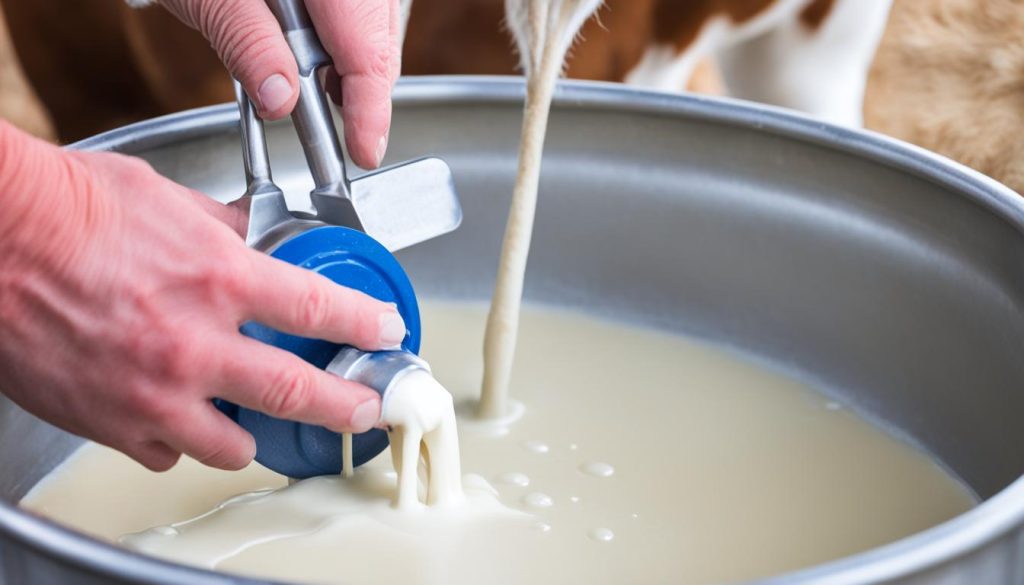
| Technique | Description | Benefits |
|---|---|---|
| Gentle Teat Cleaning | Using a clean, damp cloth or pre-milking wipe, gently clean each teat to remove dirt and bacteria before milking. | Prevents contamination and maintains udder health. |
| Strip Testing | Strip each teat a few times before milking to ensure there are no abnormalities or signs of mastitis. | Early detection of mastitis and prevention of contaminated milk entering the bulk tank. |
| Rhythmical Hand Milking | Maintain a steady and consistent rhythm while hand milking, following the natural pulse of the cow’s udder. | Maximizes milk flow and minimizes stress on the cow’s udder. |
| Complete Emptying | Ensure each quarter of the udder is completely emptied during hand milking to prevent mastitis and discomfort for the cow. | Prevents potential mastitis and maintains cow comfort. |
Transitioning From Hand Milking to Machine Milking
Milking cows by hand has long been the traditional method of extracting milk. However, with advancements in technology, many dairy farmers are transitioning to machine milking for increased efficiency and productivity. Automatic milkers, also known as milking machines, have revolutionized the dairy industry, providing numerous benefits for both farmers and cows.
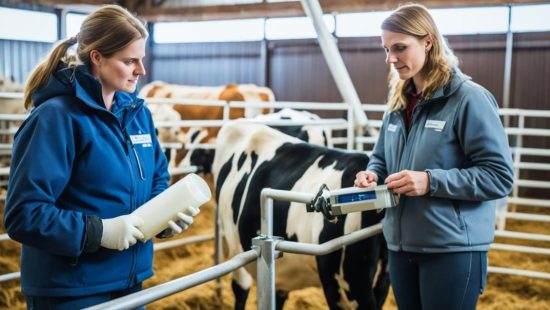
Understanding Automatic Milkers
Automatic milkers are mechanical devices designed to imitate the action of hand milking. They consist of a vacuum system, pulsator, and milking cluster, enabling simultaneous milking of multiple cows. These machines require proper installation and calibration to ensure accurate and efficient milking.
Setting up milking machines involves careful calibration of vacuum pressure, attachment of milking clusters, and proper alignment with the cow’s udder. It is crucial to follow the manufacturer’s instructions and consult with experts or experienced dairy farmers for guidance. During milking, the machine should be positioned to allow easy access to the udder and prevent discomfort for the cow. Proper teat placement and regular monitoring of milk flow are essential for effective milking.
Maintenance and Hygiene for Milking Equipment
Maintaining milking equipment is crucial for optimal performance and milk quality. Regular cleaning and sanitization of milking machines, including the milking clusters and vacuum system, are necessary to prevent bacterial contamination and ensure cow health.
Additionally, routine inspections and maintenance of milking equipment, such as checking for worn or damaged parts, are essential for long-term functionality. Proper lubrication and regular replacement of rubber components contribute to consistent milking efficiency. Hygiene practices, such as wearing clean gloves and washing hands thoroughly, are vital when handling milking equipment to minimize the risk of bacterial transmission and maintain milk quality.
What is the Process of Milk Cow? Exploring Different Methods
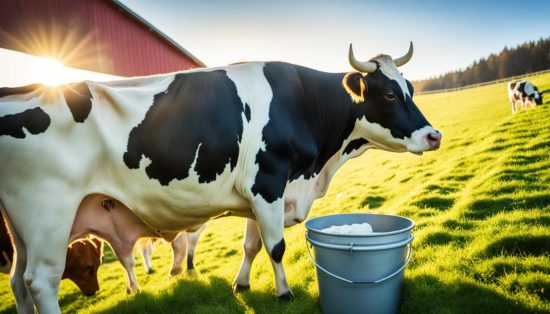
In the world of dairy farming, milking cows is a fundamental process that ensures a steady supply of fresh milk. However, there are various methods used to milk cows, each with its own set of pros and cons. By exploring these different methods, you can gain a deeper understanding of the cow milking process and the techniques involved.
Traditionally, hand milking has been the most common and widely practiced method. This involves manually extracting milk from the cow’s udder using your hands. Hand milking allows for a close connection with the cow and enables you to closely monitor the milk flow and the condition of the udder. It requires skill and practice to master the technique, but it can be a rewarding and intimate experience.
On the other hand, machine milking has gained popularity in modern dairy farming. Milking machines are designed to imitate the natural sucking action of a calf, making the process more efficient and less labor-intensive. These machines are equipped with suction cups that attach to the cow’s teats, gently extracting the milk. Machine milking can be faster and more hygienic, ensuring a consistent and controlled milking process.
Additionally, there are other milking methods that may be used, such as robotic milking systems. These automated systems utilize advanced technology to autonomously milk cows. Robotic milkers are equipped with sensors that detect the cow’s presence and position the milking cups accordingly. This method offers flexibility and convenience, freeing up time for farmers to focus on other aspects of farm management.
It’s important to note that each milking method has its own advantages and considerations. The suitability of a method depends on factors such as herd size, farm infrastructure, and the goals of the farmer. Some farmers may prefer the traditional approach of hand milking for smaller herds, while larger-scale dairy operations may opt for machine milking to maximize efficiency.
By exploring and understanding the different methods of milking a cow, you can make informed decisions about which approach aligns best with your farming practices and goals. Whether you choose to embrace tradition or embrace the benefits of modern technology, the key is to prioritize the well-being and comfort of your cows while ensuring a steady supply of high-quality milk.
Caring for Your Cow: Health and Nutrition
Proper cow health and nutrition are vital for ensuring the well-being and productivity of your lactating cows. By providing a balanced diet, monitoring their health, and incorporating mineral supplements, you can support optimal milk production and quality. Let’s explore these essential aspects of cow care.
Importance of a Balanced Diet for Lactating Cows
A balanced diet is crucial for lactating cows to meet their nutritional needs and sustain milk production. A diet rich in high-quality forage, such as grass or hay, provides essential nutrients and fiber. Additionally, supplementing with concentrates like grains, protein sources, and minerals helps meet the increased energy requirements of lactating cows, aiding in milk production and cow health. Consult with a veterinarian or nutritionist to develop a tailored feeding plan that suits your cow’s specific needs.
Regular monitoring of your cow’s health is essential for detecting any issues that may impact milk quality. Keep a close eye on their behavior, appetite, and overall appearance. Look out for signs of illness, such as reduced milk production, weight loss, or changes in manure consistency. Conduct regular veterinary check-ups and ensure necessary vaccinations and deworming protocols are followed. Identifying health problems early allows for timely intervention and better milk quality.
Role of Mineral Supplements and Hydration
Mineral supplements play a crucial role in supporting cow health and milk production. Essential minerals like calcium, phosphorus, and magnesium help maintain strong bones, muscle function, and overall physiological balance. Providing mineral supplements formulated specifically for lactating cows helps bridge any nutritional gaps in their diet. Additionally, proper hydration is essential for optimal digestion, milk production, and overall cow health. Ensure access to clean and fresh water at all times.
To summarize, caring for your cow’s health and nutrition is a fundamental aspect of successful dairy farming. By providing a balanced diet, monitoring their health closely, and incorporating mineral supplements, you can ensure the well-being of your lactating cows and promote high-quality milk production.
FAQs on how to milk a cow
1. How do I prepare to milk a cow?
Before milking, ensure you have clean hands and wear appropriate clothing, like a smock or apron. Have all necessary equipment sanitized and ready.
2. What equipment do I need to milk a cow?
You’ll need a milking pail or bucket, preferably stainless steel, sanitized milking gloves, teat dip or sanitizer, and a milking stool.
3. How do I approach the cow for milking?
Approach the cow calmly and quietly. Establish a routine so the cow becomes accustomed to the process. Ensure the milking area is clean and comfortable for the cow.
4. How do I clean the cow’s udder before milking?
Wash the udder with warm, soapy water and a clean cloth. Rinse thoroughly to remove any soap residue. Dry the udder with a clean towel.
5. How do I milk the cow by hand?
Start by firmly but gently squeezing the teats from the top down, using a rhythmic motion. Ensure you empty each teat completely before moving to the next. Be gentle to avoid causing discomfort to the cow.
6. How do I know when to stop milking?
Stop milking when the flow of milk slows down significantly or stops altogether. You should also stop if the cow shows signs of discomfort or if the udder feels empty.

